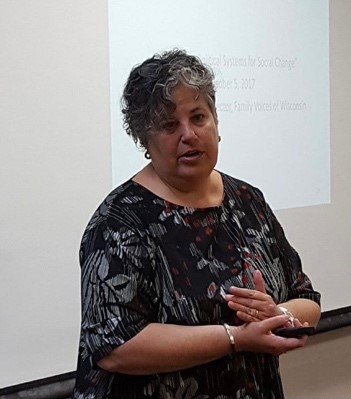
Telehealth
Family Voices Telehealth / Definitions
Telehealth Definitions
Accommodations: The adjustments or changes made to a system to make it work for a child or family’s unique needs.
Apps: An application that can be downloaded to a mobile device
Attachment: An attachment is a computer file sent along with an email message. One or more files can be attached to any email message, and be sent along with it to the recipient. This is typically used as a simple method to share documents and images.
Audio (turn on/off): In computers, audio is the sound system that comes with or can be added to a computer.
Bits and Bytes: Bits (written with lowercase “b”, such Mbps megabits per second) are smaller and are used to measure and describe the speed of an internet connection. Bytes (8 bits= 1 Byte, written with uppercase “B” such as MBps) are bigger and measure the size of data and space for that data on your computer. Bits (speed) and Bytes (file size) determine download time. The higher the bits and bytes in your broadband, the better your connection.
Broadband [over power lines (BPL)]: The delivery of broadband over the existing low- and medium-voltage electric power distribution network. BPL speeds are comparable to DSL and cable modem speeds. BPL can be provided to homes using existing electrical connections and outlets.
Broadband: A high-speed internet connection that is faster than dial up. Cable modems and DSL (Digital Subscriber Lines) are the two technologies that are most commonly available to provide access.
Cable Modem: A special modem that connects to a local cable TV line to provide a continuous connection to the internet. Cable modems send and receive data much faster than analog modems (devices that convert the computer’s digital pulses to tones that can be carried over analog telephone lines). Most cable modems are external devices (meaning outside of your computer or phone) that have two connections: one to the cable wall outlet, the other to a computer. Cable modems attach to a specific kind of card inside your computer.
Camera: A device used for recording visual images in the form of photos or videos
Captioning: A series of words superimposed on the bottom of television or motion picture frames that communicate dialogue to the hearing-impaired or translate foreign dialogue.
Cell Phone: A phone with access to a cell tower to make calls
Cellular: Technology that facilitates mobile device communication over areas made up of cells (“base stations”) and transceivers (“cell sites”). In a cellular network, the most widely used mobile transceivers are mobile phones, or cell phones. Cellular allows you to place calls, text, browse the web, check Facebook
Central Processing Unit (CPU): The part of the computer system that tells the program what to do
Chat: Online chat may refer to any kind of communication over the internet that offers a real-time transmission of text messages from sender to receiver.
Data: There are two ways that smartphones can connect to the internet; WiFi and Cellular Data. Cellular data, also just called “data” or “data plans,” uses the same network that you use to make phone calls to also connect you to the internet.
Desktop: A computer that is used at an ordinary desk, and is not portable. It includes a system unit, monitor, keyboard, and mouse.
Device: a thing made for a particular purpose, especially a piece of mechanical or electronic equipment.
Dial up: A connection from your computer that goes through a regular telephone line to connect you to the internet.
Digital & Connected Health: The use of digital, mobile, wearable or other innovative technologies that facilitate the tracking and monitoring of health status and behavior (outside of the clinical encounter) with the goal of fostering more patient-centered, technology-enabled, and insight-driven healthcare
Digital subscriber line (DSL): Moves “big” data (such as pictures or videos) over a simple telephone line that is directly connected to an analog modem. DSL is fast and provides low user subscription rates.
Downloads: In computer networks, download means to receive data from a remote system, typically a server such as a web server, an FTP (File Transfer Protocol) server, an email server, or other similar system. This contrasts with uploading, where data is sent to a remote server.
Doximity: Doximity is the largest community of healthcare professionals in the country – with over 70% of U.S. doctors and 45% of all Nurse Practitioners and physician assistants as verified members. There is an app that allows patients to virtually connect with providers in the network.
Doxy.me : A telemedicine app. Basic features available at no cost. Paid versions have more features, like waiting rooms, screen sharing, and more. HIPAA compliant.
Email: Messages distributed by electronic means from one computer or smartphone user to one or more recipients through a network.
FaceTime: A visual calling service used on Apple devices
Family Centered Telehealth: A way of providing services through a variety of digital platforms that assures the health and well-being of children and youth with special healthcare needs (CYSHCN) and their families through respectful family/professional partnerships.
Fiber: Transmits data at speeds far exceeding current DSL or cable modem speeds, typically by tens or even hundreds of Mbps.
Google Meet: A video-communication service developed by Google.
Google Translate: A free service, hosted by Google, that instantly translates words, phrases, and web pages between English and over 100 other languages.
HIPAA: The Health Insurance Portability and Accountability Act of 1996 (HIPAA), Public Law 104-191, was enacted on August 21, 1996. Sections 261 through 264 of HIPAA require the Secretary of HHS (Health and Human Services)to publicize standards for the electronic exchange, privacy and security of health information. (HHS.Gov )
Hotspot: Physical places where users can wirelessly connect their mobile devices such as smartphones and tablets, to the internet. Sometimes called “Wi-Fi hotspots” or “Wi-Fi connections.”
Insurance: A type of insurance coverage that typically pays for medical, surgical, prescription drug and sometimes dental expenses incurred by the insured. Health insurance can reimburse the insured for expenses incurred from illness or injury, or pay the care provider directly.
Interpretation: Conveys meaning of the spoken word from one language to another
iPad: A tablet created by Apple
Keyboard: The panel of keys that operate a computer
Links: Links are unique resource locators (URLs) that patients and families can “click” on to get to a specific website or location. Sometimes, you see the link, which often starts with http://www.hospitaltelemedicinevisit.org. Often, patients and families do not see the link because it’s linked to a word, such as CLICK HERE TO ENTER FOR YOUR TELEMEDICINE APPOINTMENT.
Local Area Network (LAN): Connects a group of computers, with a common communications line or a wireless link to a server over a small area (usually a square miles or less) to share resources such as documents, files, or printers.
Logins: A combination of username and password, or other information used to get into a private application
MBps: The amount of megabytes per second determines the amount of information that can be transferred over your internet connection. Sometimes you hear this referred to as “file size.”
Mac: A portable or desktop computer made by Apple (A laptop is a “Macbook”)
Mbps: The amount of Megabits per second determines the speed of the internet connection. Mbps affects how fast you can download or upload a document or picture, for example. The more Mbps, the faster the internet connection.
Mend: A telemedicine suite designed to reduce missed appointments. Includes voice and video calling. Is easy to fill out online forms. Has surveys that clinics can use to assess the provider-patient interactions, and improve patient care.
Microphone: a device that amplifies, transmits, or records sounds
Microsoft Teams: A business communication platform developed by Microsoft, as part of the Microsoft 365 family of products.
Mirror Camera: A mirror inside the camera body reflects light coming in through the lens up to a prism (or additional mirrors) and into the viewfinder so you can preview your shot. When you press the shutter button, the mirror flips up, the shutter opens and the light hits the image sensor, which captures the final image.
Mobile Hotspot: A hotspot (see definition above) that does not stay in just one location- it is mobile or portable and can move with you to give you Wi-Fi access wherever you are.
Modem: A device that enables a computer to send and receive information over a normal telephone line. Modems can either be external (a separate device) or internal (a board located inside the computer’s case) and are available with a variety of features such as error correction and data compression.
Monitor: An output device that displays information as a picture. This is the “screen” part of a computer.
Mouse: A handheld pointing device that helps you select and move things on your computer
Password: A string of characters that allows access to a computer system or service.
Personal Computer (PC): A computer used for work or personal use. It includes a system unit, monitor, keyboard, and mouse.
Platform: Telemedicine software that a health care provider uses to “see” patients and provide health care using telecommunications tools such as video chats or teleconferencing.
Portal: A website that limits who can enter it.
Random Access Memory (RAM): A form of computer memory that can be read and changed in any order, typically used to store working data and machine code. This is what allows computers to operate faster.
Release Forms: A medical release form is a document that gives healthcare professionals permission to share patient medical information with other parties.
Router: A networking device that forwards data packets between computer networks. Routers perform the traffic directing functions on the internet.
Satellite: Satellite broadband is another form of wireless broadband, and is also useful for serving remote or sparsely populated areas. These speeds may be slower than DSL and cable modem, but they are about 10 times faster than the download speed with dial-up internet access. Service can be disrupted in extreme weather conditions.
Service Set Identifier (SSID): The unique name of a wireless network. You’ll need to know the name of the wireless network to connect to it. Your computer or smartphone can search for available wireless networks; often people name their network for easy identification— anything from “Bob’s phone” to “hotel guests” to “Get off my LAN.”
Smartphone: A mobile phone that performs as many functions as a computer
Software: The programs and other operating information used by a computer.
swyMed: Telemedicine platform used by emergency responders, and home health providers. Works well in locations with bandwidth as low at 60kbps (kilobits per second). First responders can link with doctors en route.
System Unit: The purpose of the system unit is to protect the sensitive electronic parts from the outside elements such as the CPU, RAM, and other components.
Tablet: A small portable touchscreen computer
Teladoc: Allows patients to connect with a national network of doctors. Can be used on a computer or phone. Good for getting medical advice for routine illnesses.
Telehealth: Telehealth is the use of electronic information and telecommunication technologies to support:
- long distance clinical health care
- patient and professional health-related education
- public health &
- health administration
Technologies include
- video conferencing
- the internet
- store-and-forward imaging
- streaming media
- terrestrial &
- wireless communication
Telemedicine: Often used interchangeably with “telehealth” but is technically focused on the clinical aspect of care such as:
- a video a appointment with your child’s pediatrician
- a virtual therapy session with your young adult’s speech therapist
Text: An electronic communication sent and received by mobile phone.
The “G’s”: G stands for generation. 4G is the current standard of cellular networks. It has been able to support high-definition mobile TV, video conferencing and much more. 5G is the fifth and newest generation of cellular network technology that began in 2020. It is expected to allow more devices to use the network and be faster than ever before.
Translation: Deciphers meaning of the written word from one language to another.
Both translation and interpretation enable communication across languages between individuals, families, and providers, using spoken, written, or other modes of communication.
Upload: To transfer (something, such as data or files) from a computer or other digital device to the memory of another device (such as a larger or remote computer) especially via the internet.
Username: a unique identification used by a person with access to a computer or online service
Video (on/off): Refers to recording, manipulating, and displaying moving images, especially in a format that can be presented on a television and display images and text on a computer monitor.
Virtual Waiting Rooms: The process in which a patient logs into a system such as Zoom and waits for the doctor to join the appointment
WebPT: Telemedicine platform for physical therapy (PT), occupational therapy (OT), and Speech therapy using live, two-way video.
Webcam: A camera that is found on many laptops or can be bought separately and put on a laptop or any other device
Wireless Fidelity (WI-FI): Connects computers, cell phones, laptops and other devices to the internet without a cable.
Wireless Local Area Network (WLAN): Allows mobile devices to communicate without wires, using radio or infrared signals.
Wireless: Provides the ability to access the internet without a physical network connection (for example, a telephone line). Wireless uses a radio link that can be mobile or fixed. This type of link sometimes provides internet access in remote or sparsely populated areas where DSL or cable modem service would be costly to provide. Speeds are generally comparable to DSL and cable modem.
Zoom: Zoom is a cloud-based video conferencing service you can use to virtually meet with others – either by video or audio-only or both, all while conducting live chats – and it lets you record those sessions to view later. (Citation)



















